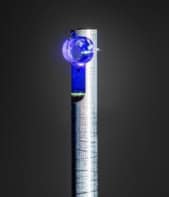Spectroscopy – the measurement of the properties of light emitted or absorbed by matter – is one of our most powerful tools to study nature. When a prism is used to separate the light from a flame in which salt has been sprinkled, distinct yellow lines become visible in addition to the usual colours of the rainbow. The wavelength of these yellow lines is directly related to the energy levels of the sodium atom, and in this way spectroscopy opens a window onto atomic structure.
The spectrum of any particular atom or molecule acts as a kind of fingerprint. For example, the measurement of previously unknown lines in the spectrum of the Sun led to the discovery of helium even before it was detected on Earth. A recent experiment on the spectrum of helium by Eric Hessels and co-workers at York University in Canada bears on one of the most fundamental constants of nature, the fine-structure constant (C Storry et al. 2000 Phys. Rev Lett. 84 3274).
The study of the spectra of the two simplest atoms – hydrogen and helium – has played a central role in the development of modern physics, especially in quantum mechanics and quantum field theory. Bohr’s initial planetary model of hydrogen was built on its successful description of the Balmer formula, a simple formula for the spectrum of hydrogen that was developed in 1885. However, the model failed to describe the spectrum of helium, which became one of the crucial tests of the “new” quantum mechanics introduced in 1925.
The theory of relativity was already 20 years old when quantum mechanics was introduced. The natural step of merging the two theories into the first relativistic quantum field theory, quantum electrodynamics (QED), was quickly taken, although certain mathematical problems were not fully resolved until the late 1940s.
An important feature of atomic spectra that arises from relativity is fine structure – so called because what at first appears to be a single line in a spectrum is actually seen to consist of two or more closely spaced lines when analysed with high precision. Fine structure arises because the electron has an intrinsic angular momentum or spin that interacts with the magnetic field that is produced, for example, as the electron orbits the nucleus at relativistic speeds. The strength of this interaction is characterized by the fine-structure constant, a, given by e2/2e0hc, where e is the charge of the electron, e0 is the permittivity of free space, h is Planck’s constant and c is the speed of light. This dimensionless constant has a value of around 1/137. The equations for fine structure contain a factor of a2, so the spacing between the lines is suppressed by over a factor of 10 000.
The way this works in helium can be illustrated by describing the transitions studied in the York experiment. Hessels and co-workers measured the transition between a state with two electrons in which the orbital angular momentum is zero (denoted 23S1) and a state with a single unit of orbital angular momentum that is split into three fine-structure levels (denoted 23PJ, where J = 0,1 and 2 are the quantum numbers that label the fine structure).
Were it not for relativity, the three states with different J would all have the same energy, and the light emitted in the transition would have a single frequency of about 277 000 GHz. However, relativistic effects mean that the states have slightly different energies, and when this light is analysed carefully, splittings of the order of 10 GHz are seen.
Accurate values of the fine-structure constant can be obtained in a number of ways – some require solid-state physics, while others involve neutron-scattering experiments. The most accurate method comes from comparing the QED theory of the magnetic moment of the electron with experiment, and gives a result with an accuracy better than four parts per billion.
So why is there so much interest in determining a using the fine structure of helium? The measurement has the potential to provide the next-most-accurate determination of the fine-structure constant. If this value agrees with the best measurement, it will provide a powerful test of the internal consistency of QED. Disagreement, however, could signify possible new physics.
Hessels and co-workers have measured a particular transition in helium known as the small interval, n12, which is the energy difference between the J = 2 and J = 1 levels. Their result of n12 = 2291 174.0 kHz has an error of 1.4 kHz, which is well below the estimated theoretical uncertainty of 20 kHz.
The experiment involves first exciting a beam of helium atoms in the 23S1 state to the 23P1 state. This state is then “tickled” using microwave energy with just the right frequency to cause the transition to the higher 23P2 state. When the atoms are detected falling back down to the original 23P1 state, this signals that the microwave frequency corresponded to the small fine structure interval n12. A major complication with the measurement is a smearing out of the energy of the states connected with their decay. This so-called natural linewidth is about 3000 kHz, so very careful measurements are required to find the centre of the line to within 1.4 kHz.
If the spacing between the lines were directly proportional to a2, the value for the fine-structure constant could immediately be determined from a comparison with theory. However, QED is a theory containing corrections that are powers of a, and in order to compare it with such an accurate experimental result requires understanding the theory to at least order a3. Unfortunately, while this level of understanding has been reached for hydrogen, only the order a2 results are known for helium because of its more complicated atomic structure. (The reason hydrogen fine structure is not competitive for determining a relates to the more rapid decay of the corresponding states compared with helium, which leads to much more severe smearing-out problems.)
Theoretical activity towards a complete calculation at the next order has intensified, largely spurred by such high-accuracy experiments. The 20 kHz theoretical error mentioned above is an estimate of the size of the uncalculated terms. When the calculation is completed, agreement with this experiment will provide a check of the highly complex theory.
Once the theory has passed this test, its predictions for another interval known as the “large interval”, n01, which is also being measured by the York group and others, should be reliable. If the experiments can reach the 1 kHz level of accuracy, a determination of a that is accurate to 17 parts per billion will result. Such a measurement will be second in accuracy only to the determination from the electron magnetic moment.
Because of the complexity of high-precision experiments such as this one, different experimentalists frequently find incompatible results that cloud the interpretation of the data. Thus it is gratifying to note that only one month after the publication of the York result, a second determination of the same splitting was reported by David Shiner and co-workers at the University of North Texas (J Castillega et al. 2000 Phys. Rev. Lett. 84 4321). Their result of 2291 175.9(1.0) kHz is in good agreement with the previous measurement, and establishes this splitting as one of the most accurately and reliable fine-structure splittings measured so far.



